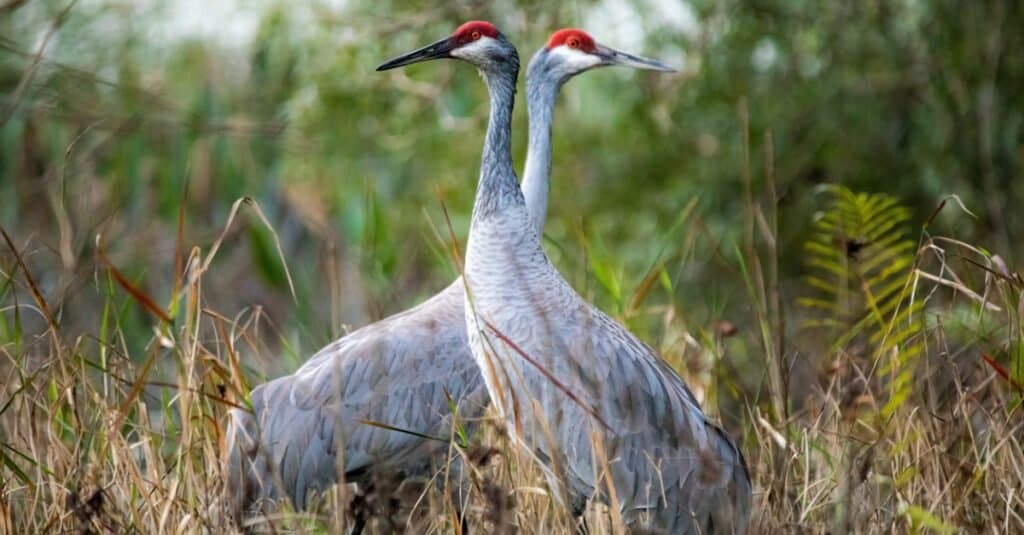The area that now makes up the State of New Jersey has a deep history going back thousands of years. Since the arrival of colonizers almost half a century ago, enduring legends and stories of monsters have developed that still circulate to this day. What is the history of the Jersey Devil cryptid? Its appearance, behavior, and habitat are explored in detail.
East Coast Cryptid: What Is the Jersey Devil?

The Jersey Devil is a cryptid that has wandered the Pine Barrens of New Jersey for centuries.
©Philadelphia Papers in 1909 – Philadelphia Newspaper – Original / License
The Jersey Devil, previously known as the Leeds Devil, is a cryptid that may be the cursed child of the Leeds family from the 1700s. It may also be a man named Titan Leeds haunting the forest. The Jersey Devil is an aggressive, swift, loud, and demonic creature that has been spotted in New Jersey for centuries.
History of the Jersey Devil
In 1735 CE, Jane Leeds, or possibly Deborah, gave birth to her thirteenth child, whom she did not want. Some legends say she was a witch inseminated by the devil, while more tame stories claim she was frustrated with having so many kids. Because of this, she cursed the child by saying he’d be a devil. While the child was born healthy, it underwent an immediate transformation and escaped through the house’s chimney.
Since the Jersey Devil was first known as the Leeds Devil, it may also be tied to another Leeds family in colonial Jersey. Daniel Leeds created an almanac that used astrology and mysticism, which was seen as blasphemous by the local Quakers. Instead of toning down his works, he leaned into occultism and Christian demonology. This caused the local Quakers to blow him off as a devil worshiper around 1700 CE.
In 1738, the son of Daniel Leeds, named Titan, passed away. Titan had continued the tradition of using occult themes in almanacs that competed with the more straight-laced almanacs created by Benjamin Franklin. To mock Titan Leeds, Franklin began referring to him as a ghost even before his death.
This substantiated the rumor that a Leeds Devil was lurking in the area. To exasperate this rumor, the Leeds crest in their almanac shows a bipedal monster with clawed feet and bat wings. It seems more than coincidental that today’s Jersey Devil is said to look like this.
Cryptid Appearance: What Does the Jersey Devil Look Like?
There isn’t a definite consensus on what the Jersey Devil looks like, though common characteristics have been reported. The Jersey Devil is winged and uses large bat wings to fly. It also stands on two hooved feet, though some think its lower extremities resemble a dragon or a kangaroo.
The Jersey Devil may have a goat or horse head with bright red eyes that glow; sometimes, it’s described as having horns. It has small arms with clawed hands and a thin forked tail, though some say it’s pointed.
How Does the Jersey Devil Behave?
The Jersey Devil moves very fast and often lets out a high-pitched scream. It’s so quick that hunting parties cannot land a shot when spotted. This cryptid is also known to kill livestock, which it does while screaming.
The viciousness of the Jersey Devil was so feared in the early twentieth century that rewards were posted for its capture by respected entities like the Philadelphia Zoo. One specifically large scare that was widely publicized resulted in school closures and canceled work days as hunting parties searched for the cryptid.
Cryptid Habitat: Where Does the Jersey Devil Live?

The New Jersey Pine Barrens are the Jersey Devil’s habitat.
©PTZ Pictures/Shutterstock.com
The Jersey Devil lives in South Jersey in the New Jersey Pine Barrens. It spends most of its time in and around Evesham in Burlington County, a Philadelphian suburb in New Jersey. However, it doesn’t always stay in this area. It also radiates out into areas throughout the Delaware Valley and west Maryland.
The Pine Barrens had a bad reputation until the middle of the twentieth century. In the 1700s and 1800s, it was a feared place full of poverty, runaway slaves, deserters, poachers, indigenous people, and fugitives. People who traveled through the area were subjected to bandits and violent crime.
Around 1912 CE, eugenicists were convinced that the Pine Barrens were full of subpar humans predisposed to criminality and immorality. These legends, as well as the continuing rural nature of the area, lent credence to many folk tales about dangerous things living in the region.
These assumptions fed into tales about a mysterious Jersey Devil monster lurking around. It also spurred other folk stories often associated with the Jersey Devil, including mysterious ghosts and other supernatural animals. It was commonly believed and reported that the Jersey Devil kept company with other monsters, bogeymen, and ghosts.
A Real Animal That May Be the Jersey Devil

Sandhill cranes may be mistaken for the Jersey Devil.
©iStock.com/GummyBone
Sandhill cranes (Grus canadensis) may have been repeatedly mistaken for the Jersey Devil. When colonists first arrived at the Pine Barrens, the sandhill cranes in the area were strange and unusual.
Seeing sandhill cranes on the East Coast past the Appalachians is rare, and spotting the subspecies known as the greater sandhill cranes (Grus canadensis tabida) is rarer. Sandhill cranes stand up to 4 feet tall and have oval bodies on thin legs adorned with big toes. The greater sandhill crane has the same basic appearance, except they can be up to 5 feet tall.
While it’s not its most common haunt, the Jersey Devil has been spotted in Cape May. Perhaps not coincidentally, wayward greater sandhill cranes are periodically spotted there. These lanky birds with huge wings may look like bipedal monsters in the dark, especially to people who don’t know what they are.
The photo featured at the top of this post is © Famartin / CC BY-SA 4.0 – License / Original
Thank you for reading! Have some feedback for us? Contact the AZ Animals editorial team.







